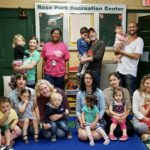The toddler at the corner of 27th and O Streets by Rose Park stopped suddenly, mesmerized. Then he pointed and squealed with delight. “A garbage truck! Look! Look!” he shouted, jumping up and down.
His parents, neighbors watering their window boxes and seniors walking their dogs all turned to stare at the garbage truck noisily emptying large bins and crushing their contents. Then they grinned at the little one. His pure excitement over the doings of everyday neighborhood life was contagious.
The sounds of young’uns in Georgetown’s residential streets and parks are becoming increasingly common. “We are bounding with children,” laughed Dave Dunning, the unofficial “mayor” of Rose Park. “There is an absolute change in the usage of Georgetown’s Rose, Volta and Montrose Parks,” he said. “More kids, parents and families.”
The youngster ogling the garbage truck had quickly turned his attention to the next big thing: carrying his brightly colored plastic ball to join at least a dozen other toddlers at their weekly early-morning “soccer” lesson with Coach John on the grassy field on 26th Street.
“We are bounding with children. There is an absolute change in the usage of Georgetown’s Rose, Volta and Montrose Parks. More kids, parents and families.” — Dave Dunning
Young baseball players were waiting their turn on a corner by the informal diamond. The new playground — with its multiple slides, climbing areas, even a pretend market stand — was full of children and wheeled carriers as their parents (a large proportion of them dads) watched their kids and chatted among themselves.
“Business is good and growing,” said “Coach John” — John Jenkins, founder and owner of Just for Kids. Jenkins started as a personal trainer in 2000 and has now become well known as a sports and skills coach for tots, starting at about 18 months of age. “I am seeing more three-to-five-year-olds now in my classes in parks throughout the area, less nannies and more parents — especially dads.” Jenkins thinks it may be due to schools cutting back on gym programs and recess, plus more telecommuting parents who want to get their children outside in an organized program.
FAMILIES STAYING
While Georgetown families are still transient — coming and going with changes in presidential administrations or based temporarily in D.C. on diplomatic or intergovernmental organization postings — a change in the traditional pattern has been observed by longtime residents.
“It used to be typical that a young couple would buy or rent a small house in Georgetown and then leave for the suburbs after the first, certainly after the second child. But, now, not so much,” said Mimsy Lindner, a former president of the Friends of Volta Park who raised four sportive children in Georgetown and coached informal soccer teams in Montrose Park. Her kids swam at Volta Park and played basketball and tennis there and at Rose Park.
“As they grew older, they loved the independence they could have in Georgetown to walk to sports or shops or even the nearby 7-Eleven without having to be driven everywhere,” Lindner said. “But now there are so many more options for kids, especially young ones.” The friends’ associations at both Volta Park and Rose Park organize children-oriented events throughout the year. This year, for the first time in years, Rose Park organized a Spring Fling to show off its newly renovated recreation center and bathroom facilities. Both parks offer summer concerts and movies, Halloween parties and winter-holiday programs.
“Half of our Rose Park board is made up of parents who plan the movies — Disney, Pixar and some old classics like ‘To Kill A Mockingbird,’” Dunning said. “We’ve added an ice-cream stand for events, including the Wednesday market. This summer, DC Parks and Recreation will organize a summer activities program at Rose Park’s new rec house, similar to the long-running one at Volta.”
More School Choice
There are also more preschool and day-care options for small children in Georgetown — and more competition. There are three Montessori programs, with educators trained in the early-skills-learning techniques, and several half-day programs at churches. But some are struggling to get students.
While the District is committed to promoting preschool experiences, it has hurt the small private schools and caregivers by offering preschool programs in the public schools, according to Monica Brewer, director of the Children’s House of Washington, a Montessori preschool at Dumbarton Church. “While the school’s demographic has always been transient in Georgetown, and majority out-of-bounds, it’s now become more Georgetown and international.”
Georgetown’s only elementary public school, Hyde-Addison, has experienced a similar change. The past three years have seen the school’s population climb to historic levels of well over 300 students and more than 20 full-time teachers. Its population is diverse — about 40-percent African American according to some estimates — with a large number of students from international families.
“Ten years ago, we sent our children to the International School because we wanted them to have a good academic program and a diverse, international student body,” said Lindner. “If they were young today, I would definitely consider Hyde-Addison, however.”
Georgetown is also seeing a growth in stores offering children’s clothes, toys, gifts and equipment. Besides the specialty stores like Egg by Susan Lazar, Little Birdies Boutique and Tugooh Toys, shops like A Mano have devoted sections of their floor space to children’s retail. That might be in response not only to growing numbers of families with schoolchildren in Georgetown but also to (surprise, surprise) grandparents.
Statistics are hard to find. Even exact population figures for Georgetown depend on what boundaries are used. But some recent census data show that the population within the boundaries of Advisory Neighborhood Commission 2E, covering Georgetown and Burleith, is about 22,000. The median age is slightly higher than the rest of the District: about 35 compared to 33.
The percentage of children under age 9 is about seven percent and the growth rate is more than one percent a year. Almost a third of the growth rate is from natural increase (i.e., births), a higher figure than in the rest of the District, according to Jamie Scott, economic development manager with Georgetown’s Business Improvement District.
“Now there are so many more options for kids, especially young ones.” — Mimsy Lindner
Reasons to Stay
A number of reasons were cited for the seeming increase in young families staying in Georgetown, even as their families (and home prices) grow. The biggest one could be a reluctance to commute long distances. Young parents who have spent a lot of time in vibrant urban communities, where they can walk and bike to work, shops and eateries, may resist changing their lifestyles once they have children. They seem willing to spend a larger portion of their income on smaller, more expensive housing — even requiring their children to share a bedroom — rather than get a large house outside the District.
“Much of the remodeling I do now in Georgetown is to make a small house more compatible for a growing family,” said Georgetown-based architect Christian Zapatka.
Along with more SUVs crawling along Georgetown’s narrow streets, a result of these demographic changes is increasing demand for good public schools. As young families spend more on housing, they have less to spend on private schools, including preschool programs. That could mean a growing number of in-district children with priority to enroll in Georgetown’s public schools.
Whatever the determining factors, families interviewed for this story said they loved living here. “It’s such a nice community of parents. The parks are beautiful with lots to do and we can walk everywhere,” commented one family, who had moved to Georgetown from a West End condo when their second child was born. “Being within walking distance to parks, schools and our work is perfect.”
- Children at Rose Park. Photos by Ricardo Jimenez.
- Children at Rose Park. Photos by Ricardo Jimenez.
- Children at Rose Park. Photos by Ricardo Jimenez.
- Children at Rose Park. Photos by Ricardo Jimenez.
- Children at Rose Park. Photos by Ricardo Jimenez.
- Children at Rose Park. Photos by Ricardo Jimenez.
- Children at Rose Park. Photos by Ricardo Jimenez.
- Children at Rose Park. Photos by Ricardo Jimenez.
- Children at Rose Park. Photos by Ricardo Jimenez.
- Children at Rose Park. Photos by Ricardo Jimenez.
- Children at Rose Park. Photos by Ricardo Jimenez.
- Children at Rose Park. Photos by Ricardo Jimenez.
- Children at Rose Park. Photos by Ricardo Jimenez.
- Children at Rose Park. Photos by Ricardo Jimenez.
- Children at Rose Park. Photos by Ricardo Jimenez.
- Children at Rose Park. Photos by Ricardo Jimenez.
- Children at Rose Park. Photos by Ricardo Jimenez.
- Children at Rose Park. Photos by Ricardo Jimenez.
- Children at Rose Park. Photos by Ricardo Jimenez.
- Children at Rose Park. Photos by Ricardo Jimenez.
- Children at Rose Park. Photos by Ricardo Jimenez.
- Children at Rose Park. Photos by Ricardo Jimenez.
- Children at Rose Park. Photos by Ricardo Jimenez.
- Children at Rose Park. Photos by Ricardo Jimenez.
- Children at Rose Park. Photos by Ricardo Jimenez.
- Children at Rose Park. Photos by Ricardo Jimenez.
- Children at Rose Park. Photos by Ricardo Jimenez.





























